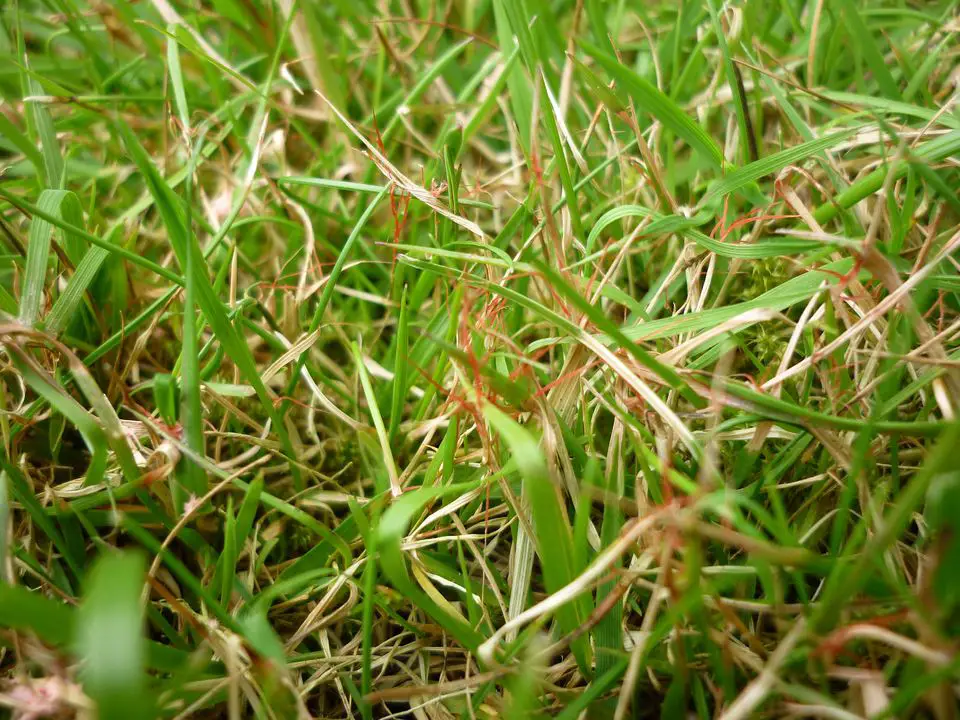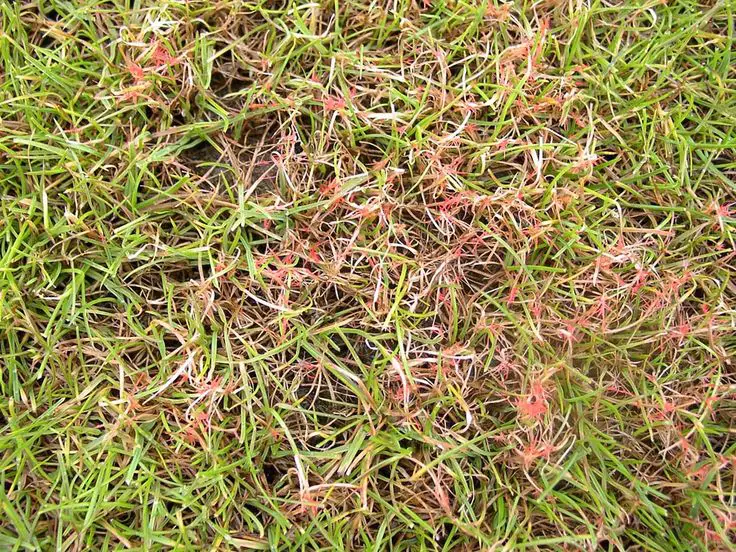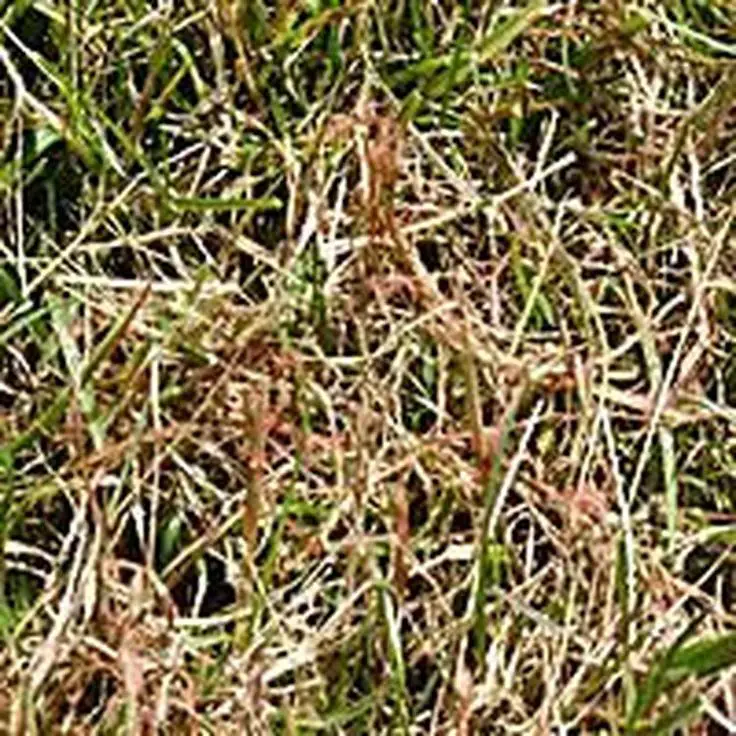How Can You Help To Keep Your Lawn Healthy
- Dont mow too low a scalped lawn is more susceptible to disease
- Mow little and often dont let the grass grow long and then cut it really short. Its too stressful for the plants
- Regular feeding
- Move lawn ornaments and toys every other day so that all the grass gets all the sunshine it possibly can
- Clear up autumn leaves as soon as they fall
- Scarify and aerate at least once a year to remove food for bad microbes and maintain the optimum soil structure for good soil microbes.
You May Like: How To Clean Mold Off Lawn Chairs
Get Rid Of Red Thread
Due to the mild weather we have experienced, our Lawn Operatives are currently noticing an increase in Red Thread across lawns in the U.K. Were here to help you identify the disease in your lawn and to explain how we can help get rid of it!
What does Red Thread look like?
- Reddish/brown patches of decaying grass
- Fine red needles protruding from the blades of grass
- Pink/reddish candy-floss like particles around the base of the leaf
- Infected blades mixed with healthy blades giving the lawn a ragged appearance
In severe cases, the grass may look scorched or yellowed in irregularly shaped or circular patches from 5 to 50cm in diameter. The patches may be widely scattered or, if close together, may amalgamate into larger spots.
How did my lawn get Red Thread?
Although high humidity is the main cause, it can also be seen in lawns affected by stress related issues such as a poor cutting regime, drought, thatch, compaction, or low nutrition .
How can GreenThumb remove Red Thread?
Generally, if our customers are receiving their regular fertiliser treatments this reduces the incidence of it. However, if the problem arises due to the conditions described above, we may recommend a liquid tonic.
If Red Thread does occur, we can treat it at the same time as we apply the scheduled NutraGreen treatments to your lawn. This will ensure that your lawn has the best chance of recovery.
What can I expect after my treatment?
Did you know?
Recommended Reading: How Much Oil In Lawn Mower
How To Treat Red Thread Lawn Disease
It is important to maintain an adequate nitrogen fertility program to lessen the effects of Red Thread. Fertilization after an outbreak of Red Thread will help the turf to âgrow outâ of the effects of the disease activity. Fertilizer will help the lawn grow and then the diseased parts of the plant can be mowed off to allow newer, healthy blades to grow. Avoid excessive watering during cool, cloudy periods that may extend the time the turf remains wet. Core aeration and overseeding with improved varieties of turf grasses that are more resistant to Red Thread are another two important cultural practices.
There are chemical control options, but by the time the red threads are seen, it is usually too late to apply a preventative disease control application. Making sure the lawn is well fertilized, mowed properly and receives the right amount of water on a weekly basis is the best approach to take when dealing with Red Thread lawn disease.
If Red Thread is a problem in your lawn, contact your neighborhood lawn care professional at Spring-Green. They will be happy to inspect your yard and provide a beneficial lawn care program.
Read Also: Who Sells Murray Lawn Mower Parts
What Does Red Thread Lawn Disease Look Like
Symptoms are often visible from the street as circular patches of tan or pink grass about 4-8 inches in diameter. Upon closer inspection, the sclerotia are easily visible, appearing like small, red threads protruding out of the grass blades, especially near the tip. Red Thread will affect the leaves, leaf sheaths and stems without killing the entire plant, unless the outbreak is severe. The infection begins as small blighted areas on leaves and rapidly enlarge, covering the entire leaf blade. The affected leaves will dry out and turn a bleached straw color.
After it has completed its life cycle, the disease produces the red threads or sclerotia. In other words, unless the weather conditions last a long time, the red threads signal the end of its activity. These threads will break off and act as âseedsâ for future outbreaks of the disease. Mowing infected areas has little impact on spreading the disease so collecting clippings during this period is not very beneficial.
How Do I Get Rid Of Red Thread

The short answer to this question is apply a nitrogen rich fertilizer or a special lawn fungicide as soon as you see red thread appearing in your lawn.
Lets look at why applying a fertilizer will help your lawn recover from this fungal infection.
This is key for two reasons.
Its also possible to apply a lawn fungicide to kill the fungus that is causing the damage to the grass. Gardeners from the U.S. could use a fungicide such as BioAdvanced Fungus Control for Lawns.
Gardeners from the U.K. could use a fungicide like Provanto Lawn Disease Control.
Both of these products should protect your lawn for up to 4 weeks. Although they can be applied at any point in the year, we would recommend that you only apply these fungicides when the weather is at its most humid during the summer months. This is the period of the year when your lawn is most susceptible to red thread.
As always, closely follow the manufacturers instructions on the packet.
Therefore, ensure that you apply a fungicide no more than once every 2 years.
Read Also: How Often Should I Water My Lawn In Colorado
What Can I Do To Prevent It And How Can I Cure It
In this case, the prevention and the cure are almost the same. Lawns that arent fed lack nitrogen, and this lack of nitrogen encourages the fungus to take over. Feed your lawn a nitrogen rich fertiliser to cure your red thread problem and to prevent it. We recommend our QUICK RELEASE: Spring / Summer once watered in, this granular feed will set to work on your lawn making it green once again, and red thread free!
Catching The Disease Early
The best way to stop the spread of brown patch fungus in your lawn is to follow the guidance in the previous section, as removing the conditions needed by the fungus to grow will force it back into dormancy. If youve just noticed that the fungus has started to grow, you can fight it back by raking and fluffing the grass in the affected area to speed up the drying process. Then, you should apply an organic fertilizer to provide the grass with a healthy dose of nutrients to fight off disease. This Garden Care Organic Fertilizer from Milorganite can be used on your lawn all year round to keep your grass and plants strong and resistant.
Also Check: Peat Moss For Grass
You May Like: Removing Clover From Lawns
Different Ways To Treat Red Thread In Lawns
There are two primary ways to treat red thread disease and it depends primarily on the severity of the infection when treatment is applied:
- Relatively minor infections: Treating red thread fungus may only be a matter of fertilizing and aerating your lawn more effectively. Adding nitrogen back into soil in the spring and early summer can reduce or eliminate the threat of red thread disease, while aeration can loosen the soil to help nutrients like nitrogen more easily reach grass roots.
- More severe infections: Its likely that a fungicide will need to be applied to curb the spread of the disease.
How To Control And Treat Red Thread Lawn Disease
One of the more common late spring to early summer diseases on cool-season grasses is Red Thread lawn disease. It is most severe on Kentucky Bluegrass, Perennial Ryegrass and Tall Fescue. There is another lawn disease that occurs at the same time and under the same environmental conditions known as Pink Patch.
The main difference between the two lawn diseases are the fruiting structures. Red Thread takes its name from the red thread-like structures called sclerotia that are produced by the fungus. Pink Patch produces tiny puffs of pink-cottony mycelium that resemble little bits of cotton candy stuck to the grass blades. Of the two diseases, Red Thread is the more common one seen in home lawns. Red Thread may develop when temperatures range from 40 to 75°F. Most grass activity occurs when temperatures range 65 to 75°F and during periods of cool, cloudy weather with long periods of evening dew.
Recommended Reading: How To Clean Lawn Mower Carburetor
How To Repair Patches On Lawn Damaged By Brown Patch Fungus
After carrying out any necessary brown patch control measures, you can repair the areas of damaged grass by overseeding the lawn. Choosing the best grass seed thats hardy to lawn disease at this stage will significantly help to reduce the chance of brown patch disease returning in the future. Following the guidance outlined in this article, as well as carefully following a proper watering and fertilization schedule will help the grass to recover and grow back even stronger than before.
Red Thread Grass: Identification And Treatment
Red Thread Grass is the most common disease lawns can suffer from, it lives in compacted soils that are lacking nitrogen and are set off by humid conditions any time of the year, but mainly from May through to early October depending on how mild the Autumn is.
It can survive in the soil for up to 2 years and can be spread by several methods, Airbourne, waterborne, dirty tools and shoes. If you have used any tools on affected areas, then to prevent the spread of the disease, thoroughly clean the tools after use.
You May Like: Milorganite Application Frequency
Why Your Lawn May Be Affected
Almost any lawn is susceptible to the red thread turf fungus. However, it is not uncommon for some lawns to have more issues than neighboring properties, due to different soil conditions, maintenance, and water patterns.
The cause of red thread and other turf diseases can be understood by looking at three factors, all of which make up a disease “triangle”: the susceptible host, the pathogen or disease itself, and an environment favorable to disease growth.
The hosts are grass plants that are lacking in nitrogen and are experiencing slower growth than in prior months. The pathogen is present in the thatch layer of a lawn and is impossible to completely remove. When the plant is weak, and the temperature and relative humidity are favorable for fungal growth, red thread will appear and continue to grow.
Manage Red Thread With Fungicides

There are several fungicides labeled to control red thread. But there are several things you should keep in mind before going this route.
First, fungicide applications can be very expensive. The best way to manage red thread with chemicals is preventively before the disease occurs with a product that contains the active ingredients azoxystrobin, penthiopyrad, polyoxin D, and propiconazole. These products must be used all year, every year.
Some products may be able to be used curatively after the disease has taken hold, but theyre most effective when the disease first appears. If being used curatively, Im often skeptical about whether its the product that temporarily cured the disease, such as red thread or dollar spot, or whether the disease disappeared due to changes in the weather/environment. Thereafter, red thread will likely re-emerge if the product is not continuously applied. So, at that point, were talking about preventive treatment throughout the year for a disease thats largely cosmetic and goes away on its own when environmental conditions are less favorable for growth. Again, fungicides are an option, but its extremely important to understand how they work.
So, to reiterate, there are fungicides labeled to temporarily cure and prevent red thread. But the least disruptive option for your lawn is to simply manage diseases through cultural management best practices.
Read Also: Who Makes Weedeater Lawn Mowers
Dispose Of Grass Clippings
If your lawn has been infected with red thread, it is important to deal with grass clippings in the proper way.
Since red thread spores can lie dormant for up to two years, you should bag up clippings and destroy them or otherwise dispose of them safely.
If your lawn has suffered an attack of red thread, you shouldnt put the clippings on the compost heap otherwise, there is a risk of them surviving, and you may end up spreading them over your lawn and reinfecting it later.
You May Like: How To Keep My Lawn Green
How To Treat Your Lawn
Since you cant control the weather or remove the pathogen one cell at a time, the best solution in the fight against red thread is to fertilize your lawn and replace the nitrogen thats been lost from springtime growth. If you didnt spread a nitrogen-rich fertilizer in the fall, then treat your lawn in early spring or as soon as you suspect you have a fungal growth. Its important to point out that treating this type of fungus can take several years of fall treatments to prevent red thread from returning in the spring.
If the growth of red thread in your lawn is severe, chemical fungicides can also be used, but these are generally avoided in residential lawns to avoid harmful chemical reactions in children and pets.
Dont let red thread or any other springtime fungi take over your lawn this spring. Be ready by letting the team at Green Acres Landscape fertilize and treat your lawn in early spring. To schedule your lawn inspection or your annual spring appointment, call us today at . We proudly serve residents and commercial properties throughout Marion County, OR, and we look forward to treating your lawn this spring.
Also Check: Craftsman Lawn Mower Oil Drain Plug
What Does Red Thread Disease Look Like
The first clue that your lawn may be suffering from redthread disease is the appearance of small straw-coloured patches in thesward. These patches usually have anirregular shape and you may notice a pinkish tinge to them.
Look a bit closer and youll see that there are tiny pink-colouredthreads attached to each blade of grass. There may also be a pale colouredcobweb like structure at the base of the plant.
This is typical of red thread disease.
If your lawn is showing slightly different symptoms, it may be suffering from a different lawn disease. Check our troubleshooting guide
When Does Red Thread Appear
In the past you would have seen it in humid periods any time from March to October. However, with todays changeable weather patterns, this summer disease can now occur at almost any time in the year in the UK. And when the grass is naturally under more stress , it will be harder to cure the red thread or lessen the aesthetic disturbance.
Recommended Reading: When To Apply Crabgrass Preventer In Iowa
Symptoms Of Red Thread
The infected grass will firstly be bleached in color the grass will turn pale cream/white. Not all grass blades will be affected, as non-infected blades may exist next to infected blades. In these circumstances the grass will appear visibly messy. In moist conditions the fungus will form the pink branching threads. Once the threads are well developed the lawn will have reddish/pinkish tinge to it in small patches, these patches may join together to form larger patches.
What Can You Do Now About Red Thread
To help protect your lawn from Red Thread we recommend the following.
Don’t Miss: Lawn Care Employees
Fixing Summer Patch Dead Spots
Summer patch is a lawn disease that results in straw-like areas in the lawn. This is caused when the fungus Magnaporthe poae infects the roots, making it difficult for the grass to absorb water and nutrients. If it progresses enough, it can kill an area of the lawn, so you may need to work on how to fix dead grass after addressing the infection.
Summer patch does well in high heat, humidity, and areas with heavy soil compaction. Over-fertilizing can also contribute to issues with summer patch. Once it is established, summer patch can be difficult to get rid of. To prevent this grass fungus, avoid over-fertilizing and over-watering. You can also apply a lawn fungus treatment in late spring as a preventative measure.
Read Also: How To Remove Mold From Plastic Outdoor Furniture
How To Identify Red Thread And Pink Patch

Red Thread and Pink Patch are fairly easy to spot
- Youll notice patches of grass turning a pinkish colour before the leaves die and turn brown.
- The patches of discoloured or dead grass can range in size from 5cm to 30cm in diameter. Sometimes these patches can join up to create a much larger area.
Within these patches, youll find one of, and often both of the following fungal growths
Red Thread
Youll see tiny pink or red threadlike structures called Stromata, around 1-2mm in length which grows from the grass leaves.
Pink Patch
This is sometimes confused with Fusarium Patch or Snow Mould. Youll now its Pink Patch because the fungal growth takes form in small distinctive cottony balls that are pink in colour. Snow Mould more resembles a spiders web.
Don’t Miss: How Much Peat Moss For Lawn
